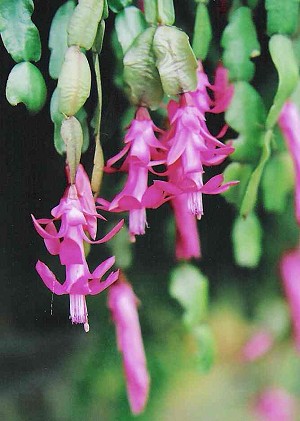
|
|
Christmas
Cactus (Schlumbergera truncata)
|
Christmas Cactus -
Schlumbergera Spp.
Schlumbergera is a genus of 6 known
tree-dwelling cacti from Brazil. These are the tropical rainforest epiphytes, growing on tree branches
where, despite the high rainfall, water drains off quickly so that "dry" conditions prevail much of the
time. Not surprisingly these cacti are quite different in appearance to their desert dwelling
cousins. They are named after
the French Frederic Schlumberger who was the owner of a famous plant collection.
This genus contains the popular Schlumbergera truncata, also known as Christmas Cactus which may flower in
white, pink, red or purple. The Easter Cactus or Whitsun cactus (Hatiora
gaertneri) which produces vivid scarlet flowers belongs to Hatiora genus.
The stems of Schlumbergera resemble leaf like pads joined one to the other and the flowers appear from areoles at the
tips. In addition, the plant is diurnal and will close up its flowers at night.
The common holiday cacti (Thanksgiving Cactus, Christmas Cactus, Easter Cactus) are composed of several closely related species in the genus Schlumbergera
(often called "Zygocactus" in older works). They are originally forest
cacti, growing as epiphytes at elevations between 1000 and 1700 meters above sea level (3280 to 5575 feet above sea
level) in the Organ Mountains north of Rio de Janeiro in southeast Brazil, South America
(not to be confused with the Organ Mountains of New Mexico in the United States of
America). They are called "Flor de maio" (May Flower) in Brazil.
Many modern holiday cactus cultivars are hybrids between Schlumbergera truncata and Schlumbergera
russelliana, first bred about 150 years ago in England.
Schlumbergera plants have a wide flat green stem that look like leaves and produce colorful
flowers. The flowers come in a wide variety of colors, red, purple, peach,
orange, pinks and creams.
The green, flattened, leaf-like structures that make up the majority of a Christmas Cactus are actually modified stem segments called
cladodes. A cladode is a stem modified for photosynthesis that looks like a leaf. It is flat for increasing the surface
area, thick for storing water and green for photosynthesis. In most cacti, the leaves have been modified into spines which have many different functions for the
plant. In the Christmas Cactus, the leaves and spines are absent.
The Christmas cactus history sheds light on how this plant became such an integral part of Christmas
festivities. Pine and fir trees are evergreens and are normally found in cold
climates. The cold and harsh winter conditions dull the spirit of many and an evergreen bough or tree warmly decorated puts the mind on a more cheerful
frame. But there are several countries where pine and fir trees are not
available. So the custom of decorating the Christmas cactus as Christmas tree came into
being. We find this tradition in the dry and hot places. Africa, Australia, some of the Latin American countries has Christmas cactus for their Christmas
tree. The tree is decorated just like pine or fir trees, but there are local or
rather, native flowers or any other decorative items.
Source:
http://en.wikipedia.org/wiki/Schlumbergera
http://en.wikipedia.org/wiki/Christmas_Cactus
http://www.theflowerexpert.com/content/giftflowers/
flowersandoccassions/christmas-cactus
http://www.christmascarnivals.com/
christmas-history/christmas-cactus-history.html
